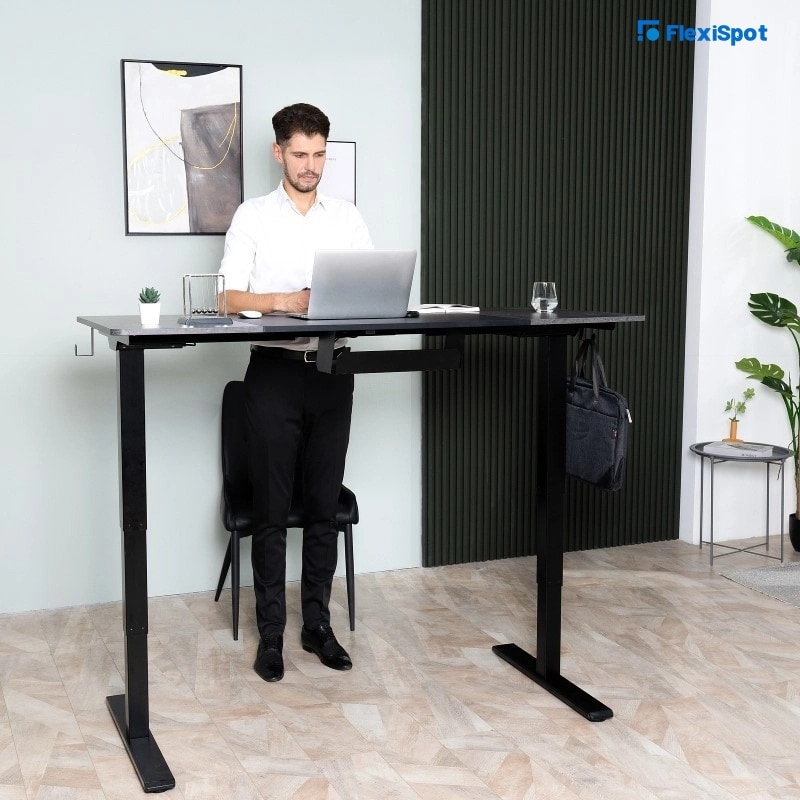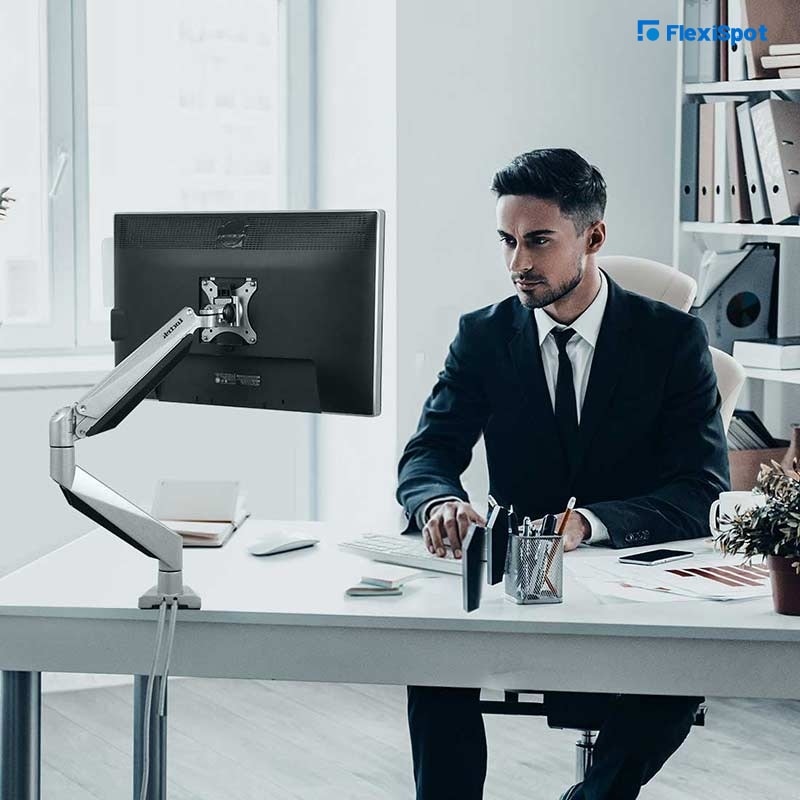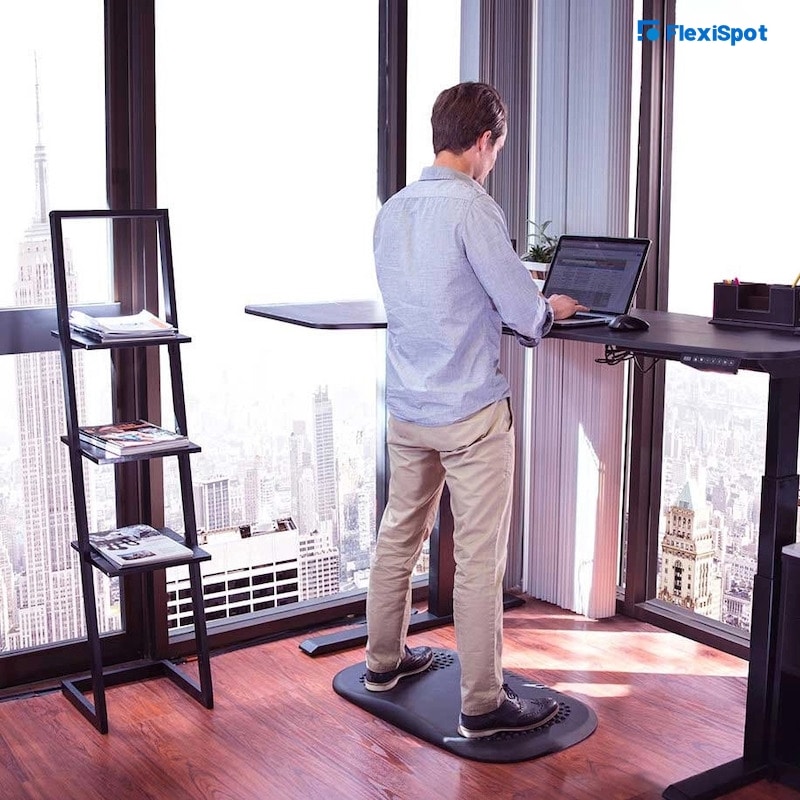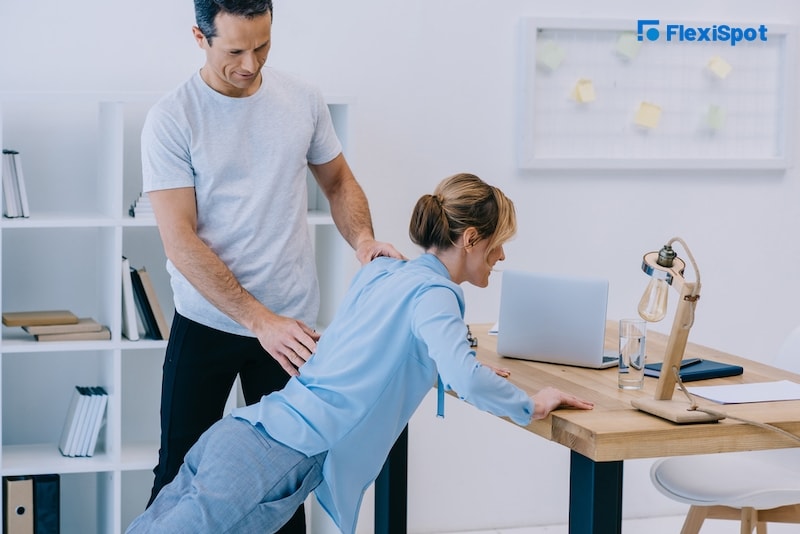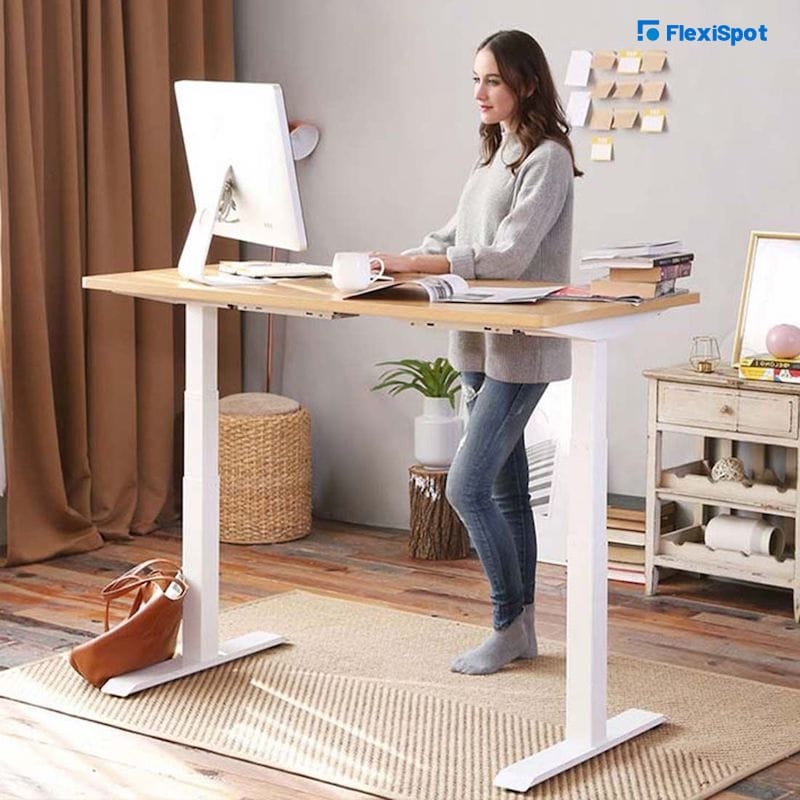Lately, there has been a lot of talk about the health risks associated with sitting all day at work. What comes to mind when you hear the words "standing desk?” For many people, the first thought is that it must be better for your health than sitting all day. And while that may be true, using a standing desk can also be tricky if you're not sure how to use it properly.
Are you looking to buy a standing desk but aren't sure how to set it up properly? Are you using a standing desk but find that you're not getting the most out of it? We’ll talk about how to properly set up and use an adjustable standing desk in this post. We'll also share some tips on how to make the switch from sitting to standing gradually so that you can avoid any potential health risks. Let's get started!
The Impact of Office Ergonomics
Imagine that instead of having a workstation with dedicated office seats, your workplace put a dining table and its accompanying chairs in the office. The immediate thought of discomfort is why we need ergonomics at the workplace. Ergonomics considers the interaction between individuals and other elements in a system in ensuring comfort and enhancing productivity.
The room’s layout, the furniture arrangement, and even placement of items all work together to bring you comfort. But, ergonomics is not an exact science. Ergonomics entails tailoring an environment to fit an individual’s unique needs. Therefore, one ergonomic setup cannot be assumed to be favorable for an entire office. However, office managers can ensure that the furniture in an office is adaptable enough to suit everyone’s ideal.
When choosing an adjustable standing desk, consider an ergonomic one. An ergonomic standing desk not only increases your productivity but also greatly reduces the likelihood of the occurrence of back pain, neck pain, and can even improve your overall posture. Poor ergonomics has been shown to lead to long-term health problems, including chronic neck and back pain, carpal tunnel syndrome, and vision problems. This can lead to hefty medical bills and thousands of hours lost to sick days.
How to Optimally Set Up and Use a Standing Desk:
There are a lot of different ways to set up and use a standing desk, and what works best for one person might not work as well for another. However, here are a few important tips to help you get started on setting up your Standing desk based on the recommended posture:
Proper posture on a Standing Desk while Standing
Here are some tips for proper posture while standing at a standing desk:
Elbows
You should adjust the height to ensure your elbows are properly placed. They should be at a 90-degree angle, and your forearms should be parallel to the desk surface. If you have to reach too high or too low to type, it means the desk is not properly adjusted.
Your wrists should be in a "floating" position, which means they should not be bent up or down. This position may take a little getting used to, but it is the healthiest way to use your hands and wrists when typing.
Why is a Proper Elbow Position Important?
There are a few reasons why proper elbow position is important when using a standing desk.
If your elbows are flexed too much (bent), it can cause tension in the shoulders and neck.
If your elbows are too straight (extended), it can lead to discomfort in the wrists and hands.
Maintaining good posture with your arms at a 90-degree angle will help evenly distribute weight throughout your body while standing, which can help reduce fatigue.
Wrists
While standing, it's important to find a neutral wrist position and never tilt your wrists up or down when using the keyboard or Mouse. Ideally, your wrists should be parallel to the desk surface like your forearms.
Why is The Wrist Position Important?
Repetitive flexing of the wrist muscles while typing can result in carpal tunnel syndrome.
Body Posture
Ensure that you maintain good posture. Your standing desk should allow your knees some room to bend a little to prevent them from locking or hyperextending. Relax your shoulders and keep your neck tall to ensure that your weight is evenly spread out. The goal is to improve your posture and limit back pain from bad posture associated with a sedentary lifestyle.
Why is Maintaining a Good Body Posture Important?
Maintaining a good posture is essential when using a standing desk. This means keeping your spine in a neutral position and maintaining a balanced stance. If you slouch, you're putting unnecessary stress on your back and muscles. Over time, this can lead to pain and even injuries.
Proper posture on a Standing Desk while Sitting
A great addition to your standing desk setup is an ergonomic seat. By using an ergonomic seat, you can take a break from standing and sitting in the same position all day. A well-adjusted ergonomic chair is a key to preventing pain and discomfort when sitting for long periods.
It's important to make sure that the seat is adjustable in terms of both height and angle to customize it for each user. The backrest should be adjustable to support your lower back, and you can recline comfortably. The armrests should also be adjustable to support your forearms and allow you to type easily.
Elbow Position
Adjust your standing desk such that the surface rests beneath your forearms. Your elbows should be bent at a 90-degree angle to keep your arms straight and wrists steady. The chair’s armrests should only barely touch your elbows to prevent any discomfort and injury to your arms and wrists.
Why is Elbow Position important?
It's important to keep your arms and hands in a neutral position while sitting to avoid joint pain and injury. Too much or too little extension or flexion can stress the joints and ligaments in the elbow, shoulder, and wrist.
Wrist Position
When sitting at a standing desk, it's important to maintain a neutral wrist position. This means that your hands should float over the keyboard, with your wrists in a neutral position (not tilted)
Try to keep your hands in a neutral position as you type. This means that your wrists should be straight, and your hands should float over the keyboard rather than resting on it. You may also want to avoid tilting your wrists up or down, as this can put stress on your joints and lead to pain.
Why is Wrist Position Important?
Incorrect wrist position can lead to carpal tunnel syndrome, a condition where the median nerve is compressed as it travels through the carpal tunnel in the wrist. This nerve compression can cause pain, numbness, and tingling in the hand and arm.
Knee and Thigh Position
The seat’s height should be adjustable so that your feet are flat on the ground and your thighs are parallel to the ground to ensure equal weight distribution. Keep your knees at a 90-degree angle. Adjust your chair to make sure that it is parallel to the back of your knees, leaving a bit of space between the edge of the seat cushion and the back of your knees.
Why is Knee and Thigh Position Important?
When your knees are higher than your hips, it puts unnecessary pressure on your lumbar spine, leading to back pain. Additionally, keeping your feet flat on the ground while sitting will help maintain the natural curve in your lower back.
General Posture
Pay attention to your posture. Bad posture is the main proponent of back pain, especially in people with sedentary habits. A good chair should have lumbar support in the form of padding or curvature for it to meet your lower back for maximum support and to help you avoid slouching.
How to Position Your Monitor
Make sure the top edge of the screen is in line with your eye. If it's too low, you'll end up looking down at it and straining your neck, and if it's too high, you'll have to crane your neck up to see it. Ensure the monitor is directly in front of you, not off to one side.
Again, If the monitor is too far away, you will have to lean forward which can cause neck and back problems. If the monitor is too close, your eyes will have to work harder to focus and this can also lead to eye fatigue and force you to adapt to a different posture in order to mitigate the issue
The recommended distance between the monitor and the user is typically about an arm's length away (20-40 Inches) and should allow a viewing angle of 30 degrees
To improve the flexibility of your screen and reduce instances of neck and back pain, you can use a monitor arm to hold your screen at the desired height and distance from you. Lifting the screen also frees up more desk space for you.
Under Desk Management
Setting up equipment on your workspace is guaranteed to come with cables that can get tripped on, tangled, or chewed on by pets. The sight of all that cabling can be frustrating, especially when you’re trying to use a minimalist approach in your setup. You can mount a cable management tray on the edge of the back of your desk to help keep all your cables out of the way and organized. This also ensures they remain cool and protected from dust.
Additionally, when choosing an adjustable standing desk, consider choosing a standing desk with anti-collision features. Ideally, there should be no obstructions under the table to avoid damage. However, to be safe, an adjustable desk with anti-collision features can detect obstacles when it’s in motion protecting your desk from damage and preserving your investment.
What is the Optimum Ratio Between Standing and Sitting?
A recent study from the University of Waterloo recommends that you adopt a healthy mix of sitting and standing throughout the day. The findings recommend that for every 15 minutes you spend sitting, you should spend 15 minutes to 45 minutes standing.
Applying this ratio enables you to derive the maximum comfort you can from your sit-stand desk while also helping you avoid the health issues that arise from prolonged periods of continuous standing and sitting.
Some sit-stand desks come with sit-stand reminders, which are little vibrations or sounds that remind you to get up and move around. This is a great way to ensure that you're getting up and moving regularly throughout the day. And if your desk doesn't come with a sit-stand reminder, you can always use a timer or an app to remind yourself to get up and move.
How to Prevent Pains When Using a Standing Desk
Prevent your knees from locking by keeping them slightly bent. This helps your body handle your body weight better.
Use a timer to help you maintain a good sitting to standing ratio. You should not remain standing for longer than 1.5 hours. Even if you don’t switch to sitting, you can take a walk or do some stretches.
Keep your wrists relaxed and parallel to your desk to prevent carpal tunnel syndrome.
Avoid slouching or hunching forward by keeping your arms straight on the desk surface to maintain good posture and prevent shoulder and back pain.
Use accessories such as anti-fatigue mats to reduce the aches and pains experienced following prolonged standing on a hardpan surface.
Take regular breaks throughout the day to move around and stretch your muscles. Make sure to stretch your calves, hamstrings, and glutes regularly. You can do some simple stretches at your desk or take a quick break every hour or so to do some more comprehensive stretches.
Drink plenty of water (at least 8 glasses per day) to stay hydrated and help reduce fatigue
When working at a standing desk, wearing the right shoes is important to preventing pain. Shoes that have a cushioned sole and good arch support are ideal.
Make sure that your monitor is at eye level so that you don't have to strain your neck to see it.
Keep frequently used items within easy reach to avoid having to lean over or stretch when working at your desk.
Stretches and Exercises You Can Do to Prevent Pain
There are many stretches and exercises you can do to prevent pain. Here are a few of our favorites:
Hamstring Stretches and Curls
This stretch is great for the hamstrings, which are often tight and prone to injury. To do this stretch, stand with one foot in front of the other and bend forward at the waist, keeping your back straight. Reach for your toes or extend your arms parallel to the ground. Hold for 30 seconds before repeating on the other side.
Alternatively, hold onto something for support, like a railing or the back of a chair, and bend your knees. Proceed to raise, then lower your heel from your butt.
Side Lunges
There are a few different ways to do a side lunge. Here's one way:
Stand tall with your feet hip-width apart and your hands on your hips.
Step out to the side with your left foot and bend your left knee, lowering your body toward the floor. Keep your right leg straight and your upper body upright.
Pause, then slowly return to start position
Repeat this a few times to stretch your hips and glutes.
Calf Raises
Stand on your toes without bending your knees and hold that position for a few seconds before bringing your heels back down. Do this a couple of times to stretch your calves. Feel free to lean on the desk for support.
Cat/Camel Stretch
Get down on all fours with your knees hip-width apart. Inhale while you face upwards, opening up your chest. Then, exhale as you tuck your chin to your chest, rounding your back. Do this a few times, holding each position for a few seconds before letting go. This allows you to stretch your back and improves circulation.
Desk Push-Ups
To stretch your arms and shoulders, lean on the desk with your hand’s shoulder-width apart and push up and down. This movement also strengthens your wrists and helps prevent carpal tunnel syndrome.
Neck Stretch/Roll
Place your right hand over your head and pull your head down towards your right shoulder. Hold that position for a few seconds and repeat the same motion on the opposite side. Then roll your head clockwise and anti-clockwise a few times to stretch your neck.
Do's and Don'ts of Using a Standing Desk
Start slowly. Your body will need time to get used to standing all day.
Stand with good posture. This will help prevent pain and fatigue.
Wear comfortable shoes. You'll be standing all day, so you'll want shoes that are supportive and comfortable.
Maintain your desk at elbow height when standing and elbows at 90 degrees when seated.
Keep your arms and wrists parallel to the desk surface to prevent injuries.
Leave some room to bend your knees when you adjust your desk.
Don’t bend your neck and relax your shoulders.
Stretch and do some exercises every now and then to promote circulation.
Experiment with sitting and standing postures to find what is most comfortable for you.
Don't stand in the same spot all day long.
Do move around every 30 minutes or so.
Do make sure your computer monitor and keyboard are at the correct height.
Don't forget to drink plenty of water.
Conclusion
Using an adjustable standing desk the right way helps you maintain a good posture which in turn acts to protect you from neck and back pain. However, you need to maintain a ratio of 1:2 hours between standing and sitting to prevent injury. You should also incorporate some stretches and exercises into your day to promote blood circulation. Finally, get the most of your standing desk by adding accessories such as an anti-fatigue mat to aid in your posture and protect you from the health effects brought about by prolonged periods of sitting/standing. We hope the tips shared in this article help you get the most out of your standing desk.
